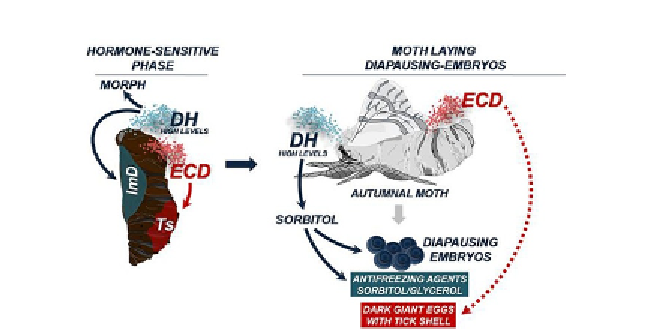Biology Reference
In-Depth Information
Figure 8.1 Diapause induction in Bombyx mori. Long summer days induce fifth last
instar larvae to develop as moth laying diapausing embryos (diapause specification)
in early autumn. During pupal
stage), DH signals over-
threshold either in target tissue (Ts, in red) and, presumably, in imaginal wing discs
(ImD) committing the development of autumnal morph (brown scales on the wings).
High levels of ecdysone (ECD, in red) and the shifted timing of its signaling since pupal
life induce the appearance of the typical diapause traits in embryos, such as dark pig-
mentation, gigantism, and egg-shell thickness. Autumnal moths have enhanced DH
titers that commit embryos to enter dormancy and enhance the levels of sorbitol, which
acts either as cryoprotector and developmental inhibitor.
life (
“
hormone-sensitive
”
Sato et al., 1994, 1993; Shiomi et al., 2007
). DH is produced in the
suboesophageal ganglion (SOG) of themoth nervous systemand released into
hemolymph via the neurohemal glands. Circulating DH signals to the devel-
oping oocytes via a G-coupled receptor, diapause hormone receptor (DHR),
to enhance glycogen levels (the source of sorbitol and glycerol) (
Homma
et al., 2006; Horie et al., 2000
). Experimental manipulations that change
the strength of DH signaling in the pupa can completely alter the develop-
mental trajectory of the future embryos. For example, a “nondiapause-
conditioned” pupae (low DH levels) will develop into a moth that lays
diapausing eggs if it is injected with DH (
Uehara, Senoh, Yoneda, Kato, &
Shiomi, 2011
). Conversely, when the SOG of a “diapause-conditioned
pupa” is removed, the resulting adult female lays nondiapausing eggs
(
Fukuda, 1951
). Taken together, these observations suggest that a “DH
sensitive” period occurs during early pupal development that dictates
which type of embryo will be laid by the emerged mother moth (
Uehara
et al., 2011
).

